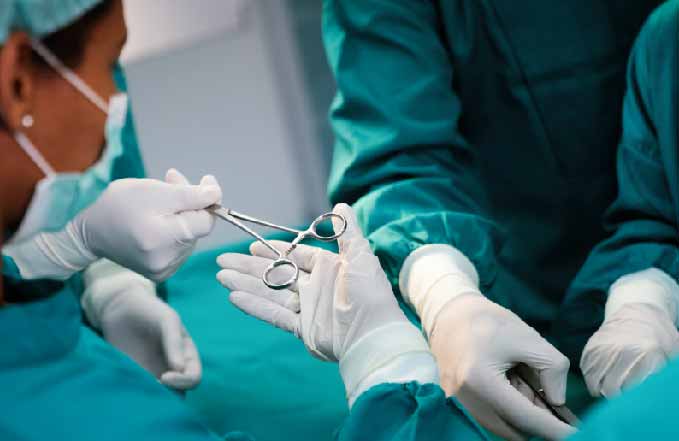La scoliose est une affection médicale caractérisée par une courbure anormale de la colonne vertébrale, qui peut entraîner des douleurs, une gêne et des limitations fonctionnelles. Touchant environ 2-3% de la population, la plupart des cas sont idiopathiques, c'est-à-dire que la cause est inconnue. Bien que la scoliose puisse survenir à tout âge, elle est le plus souvent diagnostiquée à l'adolescence. Une détection précoce et un traitement approprié sont essentiels pour gérer la maladie et prévenir sa progression. Cet article présente les principaux spécialistes et prestataires de soins de santé impliqués dans le diagnostic et le traitement de la scoliose.

Comprendre l'importance des spécialistes dans le traitement de la scoliose
La scoliose nécessite une approche multidisciplinaire pour une prise en charge efficace. Les spécialistes jouent un rôle crucial dans la fourniture de soins complets en diagnostiquant avec précision la maladie, en élaborant des plans de traitement personnalisés et en suivant les progrès du patient. Leur expertise permet aux patients de recevoir les meilleurs soins possibles et d'obtenir des résultats optimaux 1.
Chirurgiens orthopédiques : Experts dans le traitement de la scoliose
Les chirurgiens orthopédiques sont les principaux spécialistes du traitement chirurgical de la scoliose. Ils ont reçu une formation approfondie dans la prise en charge des déformations de la colonne vertébrale et dans la réalisation d'interventions chirurgicales correctives, telles que la fusion ou l'instrumentation de la colonne vertébrale. Ces interventions visent à redresser la colonne vertébrale, à réduire la courbure et à stabiliser la zone affectée. Les chirurgiens orthopédistes collaborent avec d'autres prestataires de soins de santé pour déterminer l'intervention chirurgicale la plus appropriée 2.
Pédiatres : Les prestataires de soins primaires pour le dépistage de la scoliose
Les pédiatres jouent un rôle essentiel dans la détection précoce et le dépistage de la scoliose. Ils sont souvent les premiers à identifier les signes de courbure de la colonne vertébrale lors des examens de routine. Les pédiatres utilisent des méthodes de dépistage, telles que le test d'Adam, pour évaluer la courbure de la colonne vertébrale. En cas de suspicion de scoliose, ils orientent les patients vers des spécialistes de l'orthopédie pour une évaluation et un traitement plus approfondis 3.
Les kinésithérapeutes : Soutenir la prise en charge de la scoliose et la réadaptation
Les kinésithérapeutes jouent un rôle essentiel dans la conception de programmes d'exercices et d'interventions thérapeutiques visant à améliorer la posture, à renforcer les muscles et à accroître la flexibilité. La kinésithérapie peut contribuer à soulager la douleur, à améliorer la mobilité et à prévenir la progression de la courbure de la colonne vertébrale. Les kinésithérapeutes enseignent également aux patients la bonne mécanique corporelle et la gestion des difficultés liées à la scoliose dans la vie quotidienne 4.
Les radiologues : Acteurs clés du diagnostic de la scoliose
Les radiologues jouent un rôle essentiel dans le diagnostic de la scoliose. Ils utilisent des techniques d'imagerie telles que les radiographies, les tomographies et les IRM pour évaluer la gravité et la localisation de la courbure de la colonne vertébrale. Les rapports détaillés fournis par les radiologues aident les chirurgiens orthopédiques et les autres spécialistes à prendre des décisions thérapeutiques éclairées. Un diagnostic précis est essentiel pour une planification et un suivi efficaces du traitement 5.

Généticiens : Découvrir les facteurs génétiques de la scoliose
Les généticiens étudient les facteurs génétiques associés à la scoliose, y compris les modèles d'hérédité et les mutations génétiques. L'identification de gènes spécifiques et de marqueurs génétiques aide à comprendre les causes sous-jacentes de la scoliose et peut conduire à des thérapies ciblées et à des approches thérapeutiques personnalisées pour les patients présentant une prédisposition génétique. 6.
Spécialistes de la réadaptation : Améliorer la fonctionnalité des patients atteints de scoliose
Les spécialistes de la rééducation, notamment les ergothérapeutes et les physiatres, se concentrent sur l'amélioration de la fonctionnalité et de la qualité de vie des personnes atteintes de scoliose. Ils élaborent des programmes de réadaptation personnalisés et fournissent des appareils d'assistance ou des équipements adaptés afin d'améliorer l'indépendance et la mobilité. Ils s'occupent également des complications secondaires telles que les déséquilibres musculaires ou les raideurs articulaires 7.

Spécialistes du traitement de la douleur : Traiter l'inconfort lié à la scoliose
Les spécialistes de la gestion de la douleur sont essentiels pour soulager la douleur et la gêne associées à la scoliose. Ils utilisent des techniques telles que la gestion des médicaments, la kinésithérapie, les blocs nerveux et les thérapies alternatives pour gérer efficacement la douleur. Ces spécialistes collaborent avec d'autres prestataires de soins de santé pour élaborer des plans de traitement complets 8.
Ergothérapeutes : Améliorer le fonctionnement quotidien des patients atteints de scoliose
Les ergothérapeutes améliorent le fonctionnement quotidien et l'indépendance des personnes atteintes de scoliose. Ils évaluent la capacité du patient à effectuer les activités de la vie quotidienne et développent des stratégies pour surmonter les difficultés. Il peut s'agir de recommander des équipements adaptés, des modifications du domicile ou du lieu de travail et des techniques visant à réduire les tensions sur la colonne vertébrale. 9.
Chirurgiens de la colonne vertébrale : Experts spécialisés dans les cas complexes de scoliose
Dans les cas complexes de scoliose, les chirurgiens du rachis ayant reçu une formation spécialisée dans les déformations de la colonne vertébrale jouent un rôle essentiel. Ils utilisent des techniques chirurgicales avancées telles que la résection de la colonne vertébrale ou les ostéotomies pour corriger les courbures sévères et rétablir l'alignement de la colonne vertébrale. Ces chirurgiens travaillent en étroite collaboration avec d'autres spécialistes pour assurer des soins complets 10.

Soins en collaboration : L'importance d'une approche multidisciplinaire dans le traitement de la scoliose
Une approche multidisciplinaire est essentielle pour une prise en charge efficace de la scoliose. La collaboration entre les spécialistes garantit des évaluations complètes, des plans de traitement personnalisés et un suivi continu. Cette approche aborde les différents aspects de la scoliose, notamment le diagnostic, le traitement, la rééducation, la gestion de la douleur et le soutien psychologique, maximisant ainsi les chances de réussite. 11.
Conclusion
La scoliose est une affection complexe dont la prise en charge efficace nécessite l'expertise de divers spécialistes et prestataires de soins de santé. Les chirurgiens orthopédiques, les pédiatres, les kinésithérapeutes, les radiologues, les généticiens, les spécialistes de la rééducation, les spécialistes du traitement de la douleur, les ergothérapeutes et les chirurgiens du rachis jouent tous un rôle crucial dans la prise en charge de la scoliose. Une approche multidisciplinaire permet aux patients de recevoir des soins complets et d'obtenir des résultats optimaux, en relevant les différents défis associés à la maladie.
Références
- Stokes IA, Iyer KS, Raso VJ. "Concepts actuels dans la gestion de la scoliose". Eur Spine J. 2005;14(5):529-542. doi : 10.1007/s00586-004-0832-5.
- Hresko MT. "Pratique clinique. Scoliose idiopathique chez les adolescents". N Engl J Med. 2013;368(9):834-841. doi : 10.1056/NEJMcp1209063.
- Lonstein JE, Carlson JM. "The prediction of curve progression in untreated idiopathic scoliosis during growth" (La prédiction de la progression de la courbe dans la scoliose idiopathique non traitée pendant la croissance). J Bone Joint Surg Am. 1984;66(7):1061-1071. doi : 10.2106/00004623-198466070-00008.
- Trobisch P, Suess O, Schwab F. "Scoliose idiopathique". Dtsch Arztebl Int. 2010;107(49):875-883. doi : 10.3238/arztebl.2010.0875.
- Kotwicki T, Negrini S, Grivas TB, et al. "Methodology of evaluation of scoliosis, back deformities and posture". Scoliose. 2009;4:26. doi : 10.1186/1748-7161-4-26.
- Weinstein SL, Dolan LA, Cheng JC, et al. "Adolescent idiopathic scoliosis". Lancet. 2008;371(9623):1527-1537. doi : 10.1016/S0140-6736(08)60658-3.
- Grivas TB, Vasiliadis ES, Papadopulos G, et al. "Genetic aspects of idiopathic scoliosis". Scoliose. 2010;5:6. doi : 10.1186/1748-7161-5-6.
- Monticone M, Ambrosini E, Cazzaniga D, et al. "Active self-correction and task-oriented exercises reduce spinal deformity and improve quality of life in subjects with mild adolescent idiopathic scoliosis : Results of a randomized controlled trial". Eur Spine J. 2016;25(10):3118-3127. doi : 10.1007/s00586-016-4625-4.
- Bennett MR, Greve KW, Schemitsch EH. "Gestion de la douleur dans la chirurgie de la scoliose". Colonne vertébrale. 2007;32(24). doi : 10.1097/BRS.0b013e31815b4347.
- Grivas TB, Vasiliadis HS, Dimitriou C, et al. "The role of occupational therapy in scoliosis management". Journal of Orthopedic & Sports Physical Therapy (Journal de la thérapie physique orthopédique et sportive). 2011;41(4):311-319. doi : 10.2519/jospt.2011.3587.
- Kasten MD, Betz RR, Sucato DJ. "Traitement chirurgical de la scoliose : Techniques et résultats". Orthop Clin North Am. 2008;39(3):303-313. doi : 10.1016/j.ocl.2008.01.005.

